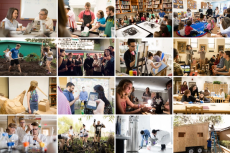
Edible experiments are making students rethink their relationship with food.
If you’ve ever noticed that ice cream tastes sweeter as it melts, there’s a reason. When food is frozen, it naturally loses sweetness. Maybe that’s why a chocolate-vanilla swirl tastes so good on a warm, sunny day.
At Rollins, students are not only learning the science behind these types of lessons, they’re replicating it in the laboratory. From finding just the right recipe for baking chocolate-chip cookies to discovering why an avocado turns brown when sliced, this class serves up an equal dose of hands-on fun and practical knowledge.

Course Title
The Science of Sustenance
Instructor
Kasandra Riley, assistant professor of chemistry


The Scoop
The Science of Sustenance explores the inextricable relationship between science and our everyday experiences as humans sustained by food. It focuses on an understanding of how individual food components, as well as physical and chemical changes, contribute to the overall quality of a food.
The premise is that science is always involved in the foods we eat, and an act of creative cooking is truly the same as conducting a science experiment.

Snapshot
When we dropped in on class in late October, students were making fish-shaped gummy candies. They got to see how changing the ratio of gelatin to sugar affected the candies’ physical traits. For instance, too much gelatin and the candy was too stiff. Too little and it became floppy.
“As a science professor, it’s really neat to see people get excited about this course, because everyone can relate to food on some level,” Riley says. “Only four of the 16 students are science majors, so the composition of the course makes it a lot of fun to have several perspectives.”

Student Perspective
“At first, as an American studies major, I thought a biochemistry class was going to be out of my academic realm,” says Tyler Vaughan ’18. “But everything I thought was turned on its head when I stepped foot into the classroom. Dr. Riley was eager to teach science to a class of mostly non-majors in ‘digestible’ bites. This experience is making me reconsider what I look for in food and my relationship with food in general.”

Fun Fact
Ever wondered why drinking whole milk is the best way to cool your mouth after eating a hot pepper? Riley gives five scientific reasons:
1) Milk contains sugar, which dilutes heat.
2) Milk contains fat, which dissolves the lipid that makes a pepper hot.
3) Milk is cool, counteracting the physical sensations of pain and heat.
4) Milk is a liquid, so it coats all the mouth’s surfaces.
5) Most importantly, the milk protein casein (a big part of cheese) binds to the hydrophobic capsaicin molecule (just like fats do) to help drag it away from the mouth’s pain receptor.



Related News
December 03, 2025
Rollins Recognized Among the Greenest Colleges in the Nation
Rollins earns a spot in The Princeton Review’s Guide to Green Colleges 2026 for its campus-wide commitment to environmental stewardship, sustainable learning, and innovative green initiatives.
December 02, 2025
Tisha and Viana ’26 Present Research at Regional Computing Conference
Computer science professor Sirazum Munira Tisha and computer science major Mauricio Viana ’26 presented their collaborative research at the 39th Annual CCSC Southeastern Conference.
December 02, 2025
Rollins Named a Top 5 School for Study Abroad
Rollins has landed in the top 5 master’s-granting institutions nationwide for the highest percentage of students who study abroad.

